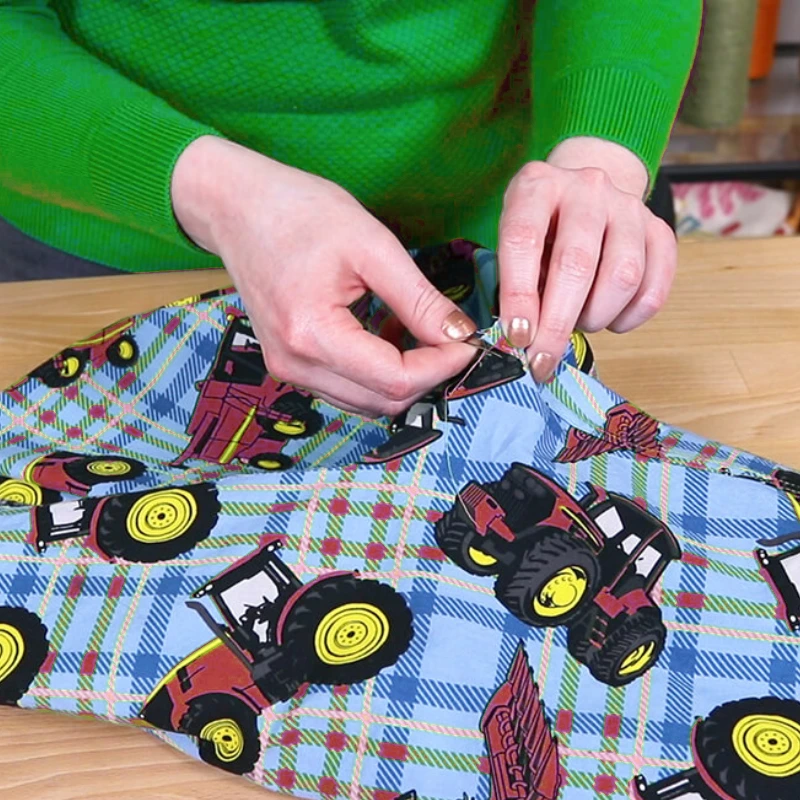When our clients ask, “How much fabric do I need for pajama pants?”, they expect clear, accurate guidance from industry pros—not vague guesses. As a top-tier sleepwear manufacturer, we’ve drilled down into this topic. Drawing from our years of bulk production, supplier benchmarking, and meticulous cost control, here’s your go-to guide. You’ll learn practical rules, insider tips, and pro-level tricks to avoid buybacks, scraps, and sleepless nights. Bookmark this—your future self will thank you!
Why Fabric Calculation Matters

Buying too much fabric hurts your bottom line; too little, and you delay production. As we negotiate bulk fabric purchases, even a 0.1-yard miscalculation blows up into tens or hundreds of wasted yards. Plus, consumer expectations are high—nobody wants mismatched prints or uneven cuts. That’s why fabric estimation isn’t just an afterthought; it’s a core competency in professional garment manufacturing.
Basic Fabric Yardage Rules
For adult pajama pants in standard woven cotton/flannel:
- Full‑length, relaxed cut = 2 to 3 yards (depending on fabric width and print layout)
- Cropped or capri length = ~2 to 2½ yards
- Shorts version = 1 to 1½ yards
- Children’s pants = 0.5 to 2 yards, based on size
Key Fabric Variables That Affect Yardage
How many yards of fabric for pajama pants? the correctness can be guaranteed by calculation.
Fabric width variations (45″ vs 60″)
Fabric width dramatically changes yardage needs. Wider 60″ material allows side-by-side leg placement, reducing wasted length. Narrower 45″ often increases yardage by ~0.2–0.4 yards. Home-sewing guides (e.g. Sewing For Dummies) note this clearly: “pants take about 1¼ to 1½ yards depending on width” In our facility, we use standardized 60″ cloth for nesting efficiency and minimal waste.
One‑way prints & nap fabrics
Directional fabrics, plaids, and napped materials need extra length so prints align upward. From experience and home-sewing resources, add 0.25–0.5 yards per garment to account for lifting and matching. Without this buffer, seams and design lines often misalign—jeopardizing your professional finish.
Pajama Fabric Material

| Fabric Type | Material Composition | Weight (GSM) | Best For | Pros | Cons |
|---|---|---|---|---|---|
| Cotton (Woven) | 100% Cotton | 120–180 | Summer, year-round basics | Breathable, soft, easy to sew | Can wrinkle easily, may shrink after wash |
| Flannel | Cotton or Cotton Blend | 180–250 | Fall/Winter sleepwear | Warm, soft brushed texture, cozy feel | May pill over time, heavier to sew |
| Knit Cotton (Jersey) | 100% Cotton or Cotton/Spandex | 140–200 | Stretchy, comfortable styles | Soft stretch, flexible fit, great for kids/adults | Curling edges when cutting, may lose shape over time |
| Tencel (Lyocell) | 100% Lyocell | 130–170 | Luxury or eco-friendly lines | Silky drape, moisture-wicking, sustainable | Slippery to sew, more costly |
| Rayon Challis | 100% Rayon | 120–160 | Lightweight and drapey PJs | Fluid drape, cool to the touch | Can fray, needs delicate handling |
| Silk/Satin | 100% Silk or Poly Blend | 80–120 | Luxury/lounge sets | Luxurious feel, elegant finish | Expensive, tricky to sew, high maintenance |
| French Terry | Cotton/Spandex or Poly Blends | 200–300 | Lounge pants, jogger PJs | Soft, stretchy, great for cooler months | Can be bulky for slim designs |
| Linen Blends | Linen/Cotton or Linen/Viscose | 150–200 | Breathable warm-weather PJs | Durable, natural texture, cool hand-feel | Wrinkles easily, may require ironing |
| Bamboo Rayon | Bamboo/Viscose Blend | 150–190 | Eco-conscious and soft PJs | Hypoallergenic, soft, breathable | Can shrink, needs gentle washing |
| Polyester Fleece | 100% Polyester | 200–300+ | Cold-weather pajamas/loungewear | Very warm, plush, durable | Not breathable, prone to static |
Factory vs. Handmade Fabric Considerations
Handmade constraints
Home sewists often lack optimized nesting, fabric width, and cutting schemes. Without factory tools, they might overbuy by 25–30% just to ensure there’s enough for adjustments. A Reddit user shared:
“2 m is probably enough for full length… but 2.5 m to be on the safe side”
This buffer makes sense for crafters, but from a production perspective, it drives cost and inefficiency.
Factory advantages
Our manufacturing setup uses CNC cutters and digital nesting: pattern pieces are tightly packed in 60″ width cloth with ±0.02‑yard accuracy. We only add 5% buffer, lower than typical home-sewing buffer. Bulk buying further ensures width consistency, dye lot uniformity, and traceability—advantages essential for professional operations.
Industry Standards and References

Our processes adhere to recognized textile and measurement standards:
- ISO 5084 specifies textile thickness measurement protocols
- ISO 3754, ASTM, and CFR 1610/1615/1616 govern material properties and flammability.
- Wikipedia’s “Textile testing” outlines tests like thread strength and cloth drapability
These standards form the backbone of compliant product quality and sourcing rigor in our facility.
Our Experience as Pajama Manufacturers
With over 100,000 pajama pant units produced across sizes S–4X and children’s lines, our internal ERP yardage calculator is grounded in real data:
- Full-length adult pants: avg 2.3 yards
- Cropped styles: avg 1.9 yards
- Shorts: avg 1.3 yards
We continually validate this with fabric swatch trials and shrinkage testing. Each production roll is tagged with lot and shrinkage data—ensuring reliable yardage planning for every PO.
Summary Yardage Table
| Style & Size | Fabric Width | Print Direction? | Total Yardage |
|---|---|---|---|
| Adult full-length relaxed pants | 60″ | No | 2.3 yd |
| Adult full-length relaxed pants | 60″ | Yes (+0.25) | 2.55 yd |
| Adult full-length relaxed pants | 45″ | No | 2.5 yd |
| Adult full-length relaxed pants | 45″ | Yes (+0.25) | 2.75 yd |
| Adult cropped pants | 60″ | No | 1.9 yd |
| Adult cropped pants | 45″ | No | 2.2 yd |
| Adult shorts | 60″ | No | 1.3 yd |
| Children’s full-length (6–12 sizes) | 45–60″ | No | 0.5–2.0 yd |
| Plus-size full-length (2X+) | 60″ | Yes (+0.25) | ~2.8 yd |
| Heavyweight flannel full-length | 60″ | Yes (+0.4) | ~2.9 yd |
FAQ
What about knit fabrics?
Knit fabrics are typically more forgiving due to their stretch, which allows for greater flexibility in fit. However, yardage requirements remain close to woven fabrics. You’ll still need about 2–2.5 yards for full-length adult pajama pants depending on size. Be sure to stabilize areas like waistbands and hems when cutting. Always factor in shrinkage—especially for cotton knits—and prewash accordingly. If using rib knit or separate waistbands, add an additional ¼ yard. Overall, knits offer comfort and ease, but require careful handling during cutting and sewing.
How much for matching pocket fabric?
If you’re adding patch or in-seam pockets and want them to blend perfectly with the body fabric, we recommend reserving an extra ¼ to ½ yard. This ensures you can cut the pocket pieces from the same print repeat or fabric grain. When dealing with stripes, plaids, or directional prints, matching requires strategic placement—more so if the pockets are exposed or oversized. Additionally, for contrast pockets using another fabric, a ¼ yard of lightweight cotton is typically sufficient. Consistency in pocket placement elevates the overall aesthetic and shows attention to detail.
Should I prewash before cutting?
Prewashing is essential to prevent post-construction shrinkage, especially with natural fibers like cotton or flannel. Most fabrics shrink between 2–7% on the first wash. We recommend washing the fabric the same way the final garment will be laundered—cold or warm cycle, tumble dry. Prewashing also removes excess dye, chemical finishes, and relaxes the fabric. After drying, press it flat to restore shape before cutting. Neglecting to prewash can result in twisted seams or ill-fitting garments after the first wear—issues that are completely avoidable with a single prewash step.
Does elastic length affect yardage?
The actual elastic used for the waistband doesn’t significantly affect fabric yardage; it’s a separate material typically 1–1.5 inches wide and cut based on waist measurements minus stretch. However, if your waistband casing is made from self-fabric (the same material as the pants), then you’ll need to account for its height—usually 3–4 inches folded—and add roughly ⅛ yard to your estimate. This applies more in design-centric or wide-band styles. For standard sleep pants, elastic length planning is more about comfort and fit than yardage changes, but it should not be overlooked.
Are buffer estimates lower for bulk?
Yes, they are significantly lower. In professional manufacturing environments, we use optimized fabric nesting software and cutting machines to minimize waste. This allows us to work with a fabric buffer of just 5–10%. By contrast, home sewers often require 20–30% extra due to layout inefficiencies, unexpected shrinkage, and design improvisation. Our ERP system tracks real-time fabric usage, which improves accuracy over time. Lower buffers in bulk also translate into cost savings and less environmental impact—key advantages for wholesale buyers and eco-conscious brands alike.
How Many Yards of Fabric for Adult Pajama Pants
For adult pajama pants, you’ll typically need 2 to 2.5 yards of fabric if using 60″ wide material. If your fabric is 45″ wide, plan for 2.5 to 3 yards. Add extra if using directional prints or sewing plus sizes.
How Many Yards of Fabric for Men’s Pajama Pants
Men’s pajama pants usually require 2.5 to 3 yards of fabric, depending on height and size. For taller men or wide-leg styles, opt for 3 yards. Use 60″ wide fabric for best efficiency and add ½ yard for directional patterns or shrinkage buffer.
Conclusion
This all‑in‑one guide delivers comprehensive, professional-grade advice on fabric yardage for pajama pants—distilled from thousands of factory runs, industry standards, real testimonials, and hands-on expertise. Whether you’re planning a small sewing project or large-scale production, this article gives you the accuracy, insight, and confidence to order just what’s needed—no waste, on budget, and high quality.
Bookmark it, share it, and come back when your next pajama project lands—because with this guidance, fabric purchasing is no longer guesswork—it’s a strategic advantage.


